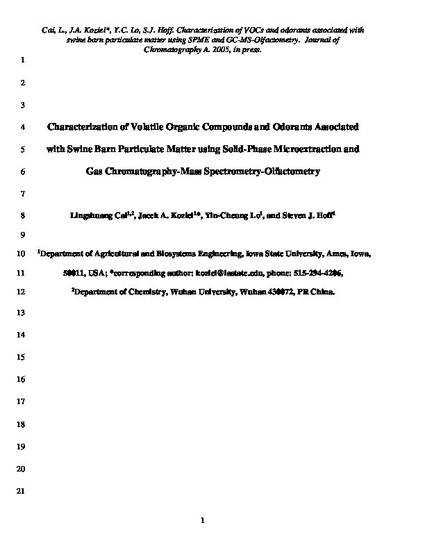
Swine operations can affect air quality by emissions of odor, volatile organic compounds (VOCs) and other gases, and particulate matter (PM). Particulate matter has been proposed to be an important pathway for carrying odor. However, little is known about the odor–VOCs–PM interactions. In this research, continuous PM sampling was conducted simultaneously with three collocated TEOM 1400a analyzers inside a 1000-head swine finish barn located in central Iowa. Each TEOM was fitted with total suspended particulate (TSP), PM-10, PM-2.5 and PM-1 preseparators. Used filters were stored in 40 mL vials and transported to the laboratory. VOCs adsorbed/absorbed to dust were allowed to equilibrate with vial headspace. Solid-phase microextraction (SPME) Carboxen/polydimethylsiloxane (PDMS) 85 μm fibers were used to extract VOCs. Simultaneous chemical and olfactometry analyses of VOCs and odor associated with swine PM were completed using a gas chromatography–mass spectrometry–olfactometry (GC–MS–O) system. Fifty VOCs categorized into nine chemical function groups were identified and confirmed with standards. Five of them are classified as hazardous air pollutants. VOCs were characterized with a wide range of molecular weight, boiling points, vapor pressures, water solubilities, odor detection thresholds, and atmospheric reactivities. All characteristic swine VOCs and odorants were present in PM and their abundance was proportional to PM size. However, the majority of VOCs and characteristic swine odorants were preferentially bound to smaller-size PM. The findings indicate that a significant fraction of swine odor can be carried by PM. Research of the effects of PM control on swine odor mitigation is warranted.
Available at: http://works.bepress.com/steven_hoff/155/

This is a manuscript of an article published as Cai, Lingshuang, Jacek A. Koziel, Yin-Cheung Lo, and Steven J. Hoff. "Characterization of volatile organic compounds and odorants associated with swine barn particulate matter using solid-phase microextraction and gas chromatography–mass spectrometry–olfactometry." Journal of Chromatography A1102, no. 1-2 (2006): 60-72. DOI: 10.1016/j.chroma.2005.10.040. Posted with permission.